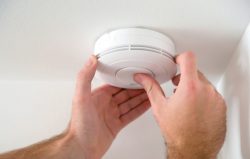Beginner’s Guide to Carbon Monoxide Detectors
June 6, 2023 6:33 pm Leave your thoughts Beginner’s Guide to Carbon Monoxide Detectors
Beginner’s Guide to Carbon Monoxide Detectors
Carbon monoxide (CO) is a colorless, odorless gas that can be deadly in high concentrations. Whether it’s from gas furnaces, stoves, fireplaces, or cars left running in an attached garage, carbon monoxide can build up quickly and without warning. One way to protect yourself and your family from CO poisoning is by investing in a carbon monoxide detector. In this beginner’s guide, we’ll cover everything you need to know about these essential safety devices.
What is a Carbon Monoxide Detector?
A carbon monoxide detector is a device that monitors the level of carbon monoxide in the air and alerts you if the levels become dangerously high. These detectors come in various sizes and types, some of which feature digital displays that show real-time CO levels, while others use alarms to notify you when CO levels reach a dangerous level.
Types of Carbon Monoxide Detectors
There are two primary types of carbon monoxide detectors: battery-operated and hardwired. Battery-operated detectors are powered by batteries, making them portable and easy to install. Hardwired detectors, on the other hand, are connected to your home’s electrical system and typically require professional installation.
Additionally, there are combination smoke and carbon monoxide detectors that detect both smoke and CO. These combination detectors can be a good option for those who want to reduce the number of devices in their home or who do not have a smoke detector installed.
Where to Install Carbon Monoxide Detectors
Carbon monoxide detectors should be installed in every room of your home that has a fuel-burning appliance or garage with an attached living area. They should be placed high up on walls or ceilings, as CO gas is lighter than air and will rise. Avoid placing CO detectors near windows or doors, as drafts can cause inaccurate readings.
It’s also important to have a detector installed on each level of your home, including the basement. This will help ensure that any CO buildup is detected quickly, regardless of where it originates.
How to Test Carbon Monoxide Detectors
Just like smoke detectors, carbon monoxide detectors should be tested regularly to ensure they are in proper working order. The easiest way to test a CO detector is by pressing the “test” button on the device. This will trigger the alarm, and you should hear a loud, piercing sound.
If your detector does not have a “test” button, you can test it by blowing out a candle and holding it near the device. The smoke from the candle should trigger the alarm.
How to Maintain Carbon Monoxide Detectors
To ensure that your carbon monoxide detectors stay in proper working order, they should be cleaned regularly with a soft, dry cloth to remove any dust or debris that could interfere with their operation. Additionally, the batteries in battery-operated detectors should be changed every six months to ensure they have enough power to operate properly.
It’s also important to replace your carbon monoxide detector every five to ten years, depending on the manufacturer’s recommendations. Over time, the sensors in these devices can become less sensitive to CO gas, making them less effective at detecting dangerous levels of the gas.
What to do if Your Carbon Monoxide Detector Goes Off
If your carbon monoxide detector goes off, it’s important to act quickly to get yourself and your family to safety. First, get everyone out of the house and into fresh air. If anyone is experiencing symptoms such as dizziness, nausea, or headache, seek medical attention immediately.
Next, call 911 or your local fire department to report the incident. If you believe you have a carbon monoxide leak, do not attempt to find the source of the leak yourself. Instead, wait for emergency personnel to arrive and let them handle the situation.
Conclusion
Carbon monoxide detectors are essential safety devices that can help protect your family from the dangers of CO poisoning. By understanding the different types of detectors available, where to install them, how to test them, and how to maintain them, you can ensure that your home is a safe and healthy place to live. If you don’t already have a carbon monoxide detector in your home, invest in one today. It may just save your life.
Interested in installing carbon monoxide detectors in your home? Be sure to contact our team of biohazard consulting professionals here at HealthSafe Inspections, Inc. to learn more about what we can do for you! Call us today!
Categorised in: Carbon Monoxide
This post was written by admin

 Beginner’s Guide to Carbon Monoxide Detectors
Beginner’s Guide to Carbon Monoxide Detectors